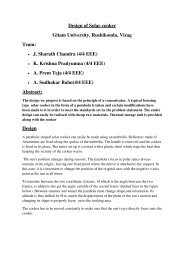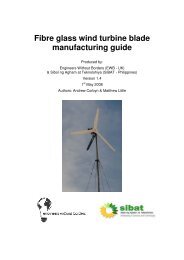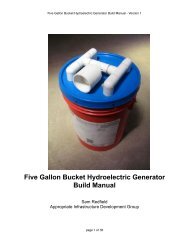Ventilated improved pit latrine technical brief - Engineering for Change
Ventilated improved pit latrine technical brief - Engineering for Change
Ventilated improved pit latrine technical brief - Engineering for Change
You also want an ePaper? Increase the reach of your titles
YUMPU automatically turns print PDFs into web optimized ePapers that Google loves.
<strong>Ventilated</strong> <strong>improved</strong> <strong>pit</strong> <strong>latrine</strong>s Practical Action<br />
Below are the main types of <strong>latrine</strong>s:<br />
2<br />
• Traditional <strong>pit</strong> <strong>latrine</strong>s – Well known in Africa, Asia and Latin America. A simple <strong>pit</strong><br />
covered with logs. Not usually roofed, sometimes they have no walls. Cost zero, no<br />
specialist skills<br />
• SanPlat <strong>latrine</strong>s – like the traditional <strong>latrine</strong> but with a SanPlat, slightly elevated <strong>for</strong><br />
ease of use in the dark. Can be located close to house with fitted lid to prevent smell<br />
and flies.<br />
• Conventional <strong>improved</strong> <strong>pit</strong> <strong>latrine</strong>s – Again similar to the traditional <strong>latrine</strong>, but built<br />
with more solid materials, i.e. bricks, with walls and a roof. Putting hot ashes in the<br />
<strong>latrine</strong> can reduce smell and flies.<br />
• VIP <strong>latrine</strong>s – Consisting or the normal <strong>pit</strong> but with a screened vent pipe fitted. Wind<br />
ideally blows over the vent pipe.<br />
• Pour-flush <strong>latrine</strong>s – Common in southern Asia. Water seal fitted to drop hole,<br />
meaning no smell and no flies. Water is poured into the water seal to flush the toilet.<br />
Problems could be the water supply and fitting the seal.<br />
• Compost Latrines - The idea of this is to build a permanent <strong>latrine</strong> with removable<br />
<strong>pit</strong>s, to use the contents <strong>for</strong> fertiliser. 60 litres per person per year. Shallow<br />
excavation, but high cost, due to the double <strong>pit</strong> lining.<br />
This <strong>technical</strong> <strong>brief</strong> concentrates on the <strong>Ventilated</strong> Improved Pit Latrine<br />
Construction<br />
The VIP Latrine can be built from different materials. These should be chosen according to<br />
availability and cost of materials, skills available, and soil type. If the soil of the ground is<br />
very loose, it is recommended to use a lighter materials <strong>for</strong> the walls. The different materials<br />
that can be used require alternative methods of construction. In all cases, the slab is built<br />
the same and a chimney higher than the roof is constructed.<br />
This <strong>technical</strong> <strong>brief</strong> describes the construction of a mortared brick design because it is the<br />
most popular. The main materials <strong>for</strong> this <strong>latrine</strong> are; sand, gravel, bricks, bags of cement,<br />
wire mesh, chicken wire, water.<br />
Tools needed<br />
Tape measure, shovels, masonry trowels, wooden floats, buckets, karias,<br />
pliers, pombo, panga or old chisel and hammer, plastic sheeting, woven<br />
plastic sugar sacks, sisal twine, large canvas sewing needles.<br />
Sighting<br />
Choose firm soil with good drainage. It should be made in a convenient<br />
location, at least 40 meters away from any springs, streams or rivers. Note the<br />
direction of prevailing winds. Latrines should be placed downwind of the<br />
home or school. The doorway of the VIP <strong>latrine</strong> should face the wind.<br />
Excavation<br />
Mark a circle in the ground using 2 sticks and a string as shown. For a family <strong>latrine</strong>, the<br />
circle should be 1.5 metres (5 feet) across, so the string should be 75 cm long between the<br />
two sticks. For a school or community <strong>latrine</strong>, the diameter should be 1.8 metres across, so<br />
the string should mark a radius of 90-cm (3 feet)<br />
If the ground is quite rocky and very stable during rains, then the brick lining may be<br />
eliminated. In such cases reduce the radius (the length of the string) by 15cm.<br />
Do not make the hole too wide, you can endanger the occupants.







